The Toyota Camry comes in two other forms – a slightly larger/much more luxurious version called the Avalon – and a much more expensive (and only slightly nicer) version called the Lexus ES350.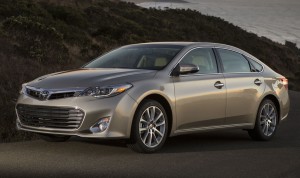
All three spring from the same basic platform – car industry jargon for a common chassis – and share major components, including the 3.5 liter V6 that’s available in the Camry and standard equipment in the other two.
This review’s about the Avalon version which – not surprisingly – is a little roomier than the physically smaller (mid-sized) Camry but which – surprisingly – is actually a bit more roomy up front than the Lexus-ized version of this car, the ES350.
It (the Avalon) also has a bigger trunk and nearly the same (very generous) legroom in the second row.
The Avalon also offers Lexus-like features such as LED headlights, heated (and cooled) seats, power rear privacy screen, a seven-inch touchscreen (same size as the ES350’s) and the same suite of apps, including Siri Eyes Free and tunes piped through a premium JBL stereo, just like the ES350.
There are a few bits and pieces you’d get in the Lexus that don’t come standard in the Avalon – but you’re not missing much…
Except the MSRP.
WHAT IT IS
The Avalon is Toyota’s largest – and most luxurious – sedan. To get nicer (or larger) you’d have to step up to Lexus.
Which will, of course, cost you Lexus money.
Base price for the Avalon (XLE trim) is $32,650 – vs. $38,000 for the base Lexus ES350.
And the Lexus is actually the smaller car.
To get a bigger car (but still less room) you’d need to step up to the LS460 – Lexus’ top-of-the-line sedan – and now you’re talking serious money.
A top-of-the-line Avalon Limited – which comes with more luxury amenities than the ES350, including tri-zone climate control vs. the ES350’s dual-zone, an 11-speaker JBL stereo, 10-way power driver’s seat (vs. the ES350’s eight-way seat), side mirrors with puddle lamps, leather (vs. “premium” vinyl) upholstery and 18-inch wheels (vs. 17s on the ES350) stickers for just slightly more than the lesser-equipped Lexus – $40,450.
And a whole lot less than a Lexus LS460 – which starts at $72,520 (and has a much less roomy back seat… believe it or not).
Possible price-equivalent cross-shops include the Chevy Impala (which shares a platform with the Cadillac XTS) and other large – and posh – but not-luxury-badged FWD sedans like the Hyundai Azera/Kia Cadenza.
Changes for the 2016 model year include a new front clip for Touring trims and minor styling changes for other Avalon trims.
Oddly – and possibly risky – the Touring trim’s suspension has been firmed up. Historically/usually, “touring” means softer and more comfortable-riding.
Not anymore.
But, non-Touring trims (XLE, XLE Plus and XLE Premium) get a suspension tuned for comfort.
A Lexus in all but name (and price).
A big car… but not a huge car (like Impala).
Quicker (and roomier) than Azera/Cadenza.
Roomier in back than in a Lexus LS460.
Electronic assists are not intrusive (radar detectors not rendered useless by constant false alarms generated by the car).
Buttons and controls are all larger than typical and easier to use as a result.
WHAT’S NOT SO GOOD
Price overlap with the Lexus ES350 – without the prestige of owning a Lexus ES350.
Impala’s roomier still – and costs less.
Some Lexus-like (and Azera-like) amenities not available – such as a panorama glass roof or a heated steering wheel.
Re-tuned Touring suspension may feel too stiff to traditional Avalon buyers – while relatively low cornering limits may be not enough for buyers who want a genuinely sporty large sedan.
Unlike the Impala – which offers a choice of four cylinder engine (standard) with the option of a V6 – all Avalons, regardless of trim, come standard with the same engine.
It’s a 3.5 liter, 268 hp V6 – the same engine that’s optional in the Camry and standard in the Lexus ES350. As in those two, the V6 is paired with a six-speed automatic which – in the Avalon – has three driver-selectable modes (Normal, Eco and Sport) as well as a driver-selectable manual-shift mode.
Though the rated output of the Avalon’s V6 is less than the Impala’s optionally available 3.6 liter, 305 hp V6 (and the Azera/Cadenza’s standard 3.3 liter, 293 hp V6) the 0-60 acceleration capability of the Avalon is about as good as it gets in this class: 6.3 seconds, dead heat with the Impala and quicker than the more powerful (on paper) Azera.
A Chrysler 300 equipped with its optional 5.7 liter V8 is quicker than all of them – but it’s a rear-drive car and so an Apples-Oranges comparison.
It’s not surprising that the Avalon’s quicker than the Impala – which is a bigger (and heavier) car. What is surprising is how much quicker the Avalon is than the Azera (and its corporate cousin, the Kia Cadenza), which is a more powerful car as well as a smaller car (closer to mid-sized while the Avalon’s full-size).
But the Hyundai is heavier – a lot heavier. It weighs 3,684 lbs. vs. 3,461 for the Avalon.
Which explains it.
It also explains the Avalon’s slightly better fuel economy – 21 city, 31 highway vs. 20 city, 29 highway for the Azera. The Toyota also edges out the V6 Impala, which carries an EPA rating of 18 city, 28 highway – which is (again) not surprising given it’s a larger (and heavier) car.
Couple of things about the Impala, though.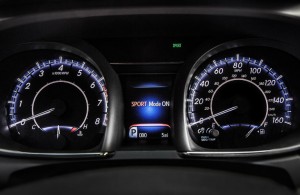
One, it is available with a four cylinder engine and while the mileage with this engine is no great shakes (22 city, 31 highway) and the acceleration is gimpy compared with the V6 Avalon’s, you can pick one up for just over $27k, sticker – which is abut $5k less than the base price of the least expensive version of the Avalon.
Two, Chevy offers a version of the Impala that can run on either gasoline or compressed natural natural gas (CNG). The mileage is not spectacular (17 city, 25 highway when running on gasoline; 16 city, 24 highway when you switch to CNG) but the advantage here is that natural gas is really cheap – even when gasoline isn’t.
If gas prices tick back up to $3 or $4 a gallon, the CNG-capable Impala could be as economical to operate as a hybrid… but without the hybrid’s complexity (or gimpy performance).
The Toyota counterpoint is the hybrid Avalon – which is capable of 40 MPG in city driving and 39 on the highway. This is twice the CNG Impala’s city mileage and nearly that on the highway, too.
Even better, the hybrid Avalon’s cheaper – $36,650 vs. $37,570 for the CNG-capable Chevy.
ON THE ROAD
Few cars are as quiet inside as the Avalon.
This includes Lexus kin like the ES350. Drive both, see for yourself. Better yet, have someone else drive both while you sit – blindfolded – in each, not knowing which car you’re in before the drive.
You will be hard-pressed to tell the difference.
Which is good for Toyota – not so much for Lexus. Good thing they’re the same outfit.
Then there’s acceleration. The Toyota’s quicker than the Lexus – notwithstanding both cars have the identical drivetrains. But the slightly smaller ES350 is about 100 pounds heavier than the Avalon (3,571 lbs. vs. 3,461 lbs.) and that accounts for the difference.
Few expect the Avalon – which does not look speedy – to be speedy.
And because it’s so quiet at speed (fifth and sixth gear are both overdrive gears, which cuts engine revs at 80-ish to not much faster than idle speed) it is very easy to lose track of just how fast you’re going. Which is why it’s an even better thing that the Avalon is radar detector-friendly. In some new cars, the e-clutter produced by the in-car “safety” systems (such as blind spot monitors, lane keep assist, parking assist and automated braking) renders radar detectors functionally unusable because of constant false alarms. I was happy to discover that the Avalon’s systems did not interfere with my radar detector – which made driving the Avalon even more enjoyable.
Toyota has firmed up the ride of the Touring trim – which is odd given the Avalon’s all about comfort rather than cornering. The good news is it’s still not particularly firm by sport sedan standards (drive an Avalon and something like a Lexus GS350 back to back and you’ll grok what I mean). But it is firmer – and if you’re used to (and like) previous iterations of the Avalon, you may notice the change and not be happy with it.
Touring models also come with 18-inch wheels – and stiffer sidewall tires. The base XLE, XLE PLus and XLE Premium trims have 17s – and these confer a softer ride.
The Touring trim’s firmer suspension calibrations do reduce body roll … if you’re cornering the Avalon at speeds most Avalon drivers will never attempt in a corner. Only car journalists throw cars like the Avalon into a sweeper posted 35 at 65.
Of course, it is because car journalists test driving Avalons that way will notice body roll – and bitch in print about it if they experience it – that Toyota cinches down the suspension in accommodation. It doesn’t make sense from the buyer’s point-of-view. But then, buyers are influenced by what they read… and it’s journalists who write… so… .
That said, the Avalon feels lighter on its feet than its rivals – because it is.
The others are fatties. And feel it.
The only real-world deficit, in my opinion, is its surprisingly wide turning circle: 40 feet vs. 38.8 for the Impala, which is almost half a foot longer overall (201.3 inches vs. 195.3 for the Toyota) and has a longer wheelbase, too (111.7 inches vs. 111 inches).
The Camry’s turning circle is just 36.7 feet.
But the Avalon’s wide-load turning circle is compensated for by a comparatively short hood/front end – which (from the driver’s perspective) makes the Avalon seem like a smaller car than it is. Especially relative to something like the Chrysler 300 – which has a coffin-length nose that seems to project ten yards ahead of the windshield.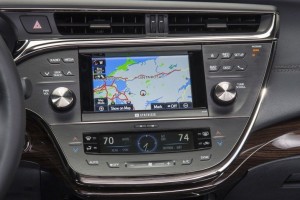
Also helpful – the exceptionally ergonomic controls, such as the large and meaty gear shift handle that conforms nicely to the shape of the underside of your hand – and the larger-than-typical buttons on the center stack (which is actually a shelf that kind of projects outward toward the center console) that are big enough such that you rarely hit the wrong button – a common problem in cars with smaller buttons.
AT THE CURB
It used to be said – a long time ago – that doctors preferred Buicks even though they could afford Cadillacs because they wanted luxury (which Buicks had) but not the gaudiness (which Cadillacs had).
The Avalon is very Lexus-like in terms of its overall niceness, the equipment it comes with (and offers). But it runs a much lower profile than a Lexus. Even though its prices roughly straddle those of the ES350 – its brother from another mother (so to speak). It is a car for the person who wants the comfort – and the luxury feel – that would come with an ES350.
But not the attention that comes with the Lexus badge.
On the outside, the Avalon is the biggest of the three. Longer overall even than the more prestigious Lexus ES (195.3 inches vs. 193.3 inches). Both cars share the same 111-inch wheelbase, though.
The Avalon has slightly more front seat legroom (42.1 inches) vs. the Lexus (41.9 inches) and just slightly less backseat legroom (39.2 inches vs. 40 for the ES350). The Camry – smallest of the brothers on the outside (190.9 inches long overall; 109.3-inch wheelbase) has nearly as much space in both rows (41.6 inches and 38.9 inches, respectively) notwithstanding it’s a mid-sized car vs. the full-sized status of the Avalon.
Trunk space is about the same in all three, too – 16 cubic feet for the Avalon vs. 15.4 for the Camry and 15.2 for the ES350.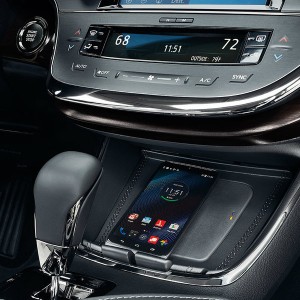
The Chevy Impala has much more front seat legroom (45.8 inches) than any car in this class but the Chevy’s backseats – though generous – are slightly less generous (39.8 inches) than the physically smaller overall Avalon’s and only slightly more generous than the much smaller overall Camry’s.
But the Impala’s trunk (18.8 cubic feet) can’t be matched by anything else in the class.
THE REST
The Avalon’s standard LCD touchscreen gets the latest version of Toyota’s Entune software/functionality – including smartphone-style finger pinch and swipe inputs. The stereo has a 20 minute cache that allows rewinding of satellite radio broadcasts – which is super helpful given SiriusXM’s occasional loss of signal when you’re driving in hilly/mountainous areas with dense tree coverage.
The USB connector ports – and the Qi wireless charging pad for your phone – are mounted conveniently ahead of the gear selector, where you can see (and easily access) them. 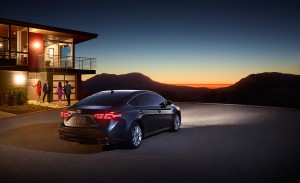
You can get (Limited trims) ventilated seats (in addition to heated seats) but you can’ t get a heated steering wheel – one of the few omissions of Lexus-like amenities. Another is the panorama roof – which there isn’t.
THE BOTTOM LINE
If you’re looking for a fancier Camry – or maybe a less pricey Lexus ES350 – an Avalon could be just the ticket.
EPautos.com depends on you to keep the wheels turning! The control freaks (Clovers) hate us. Goo-guhl blackballed us.
Will you help us?
Our donate button is here.
If you prefer not to use PayPal, our mailing address is:
EPautos
721 Hummingbird Lane SE
Copper Hill, VA 24079
PS: EPautos stickers are free to those who sign up for a $5 or more monthly recurring donation to support EPautos, or for a one-time donation of $10 or more. (Please be sure to tell us you want a sticker – and also, provide an address, so we know where to mail the thing!)






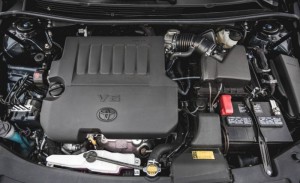









my 2011 Lexus ES has 110,000 miles and the drivers top bottom seat is torn in numerous places. I only weigh 180. Thinking about getting an Avalon seat without the heated seat. The heated seat has perforated leather, not as strong as the the plain.
Down under the Camry Touring has different struts than the other Camrys, going by my 2001 model. I was told by a mechanic the Touring has a stiffer ride than the other Camrys. Our Touring does have a stiff ride for such a heavy car (1880 kg).
Japanese Buick, ha. I can see Hito rolling down a narrow South Tokyo ghetto street. 2Pac blasting from rolled down Windows, Gold tooth gleaming in the bright glare of the rising sun. Yeahhh boyyy.
I drive a 92 Buick…
https://m.youtube.com/watch?v=BPlvfFalabU
A guy I used to work with had an Avalon. He had a pretty hefty build, and the Avalon had room for him whereas the Camry and Accord did not.
It had an excellent luxo ride. It rode like a Japanese Buick, only much quieter.
The only reason to consider the Lexus is the significantly better dealership experience. The Toyota stores near me are straight out of the 1970s… But since the cars are so reliable, you can probably tolerate being in a Toyota waiting room for the few times you’re there for service.
chiph, that’s the way I see an Avalon too. It’s the reason I prefer a large vehicle. 2 of me on the front bench and the middle person won’t be comfortable, none of us really. 3 of me and we’ll be put out and when we stop, the doors pop open when unlatched.
I’d take the model with “buckets” although I’m a captain’s chair sort of person.
Being a professional operator, riding in a car isn’t really comfortable although SUV’s with captain’s chairs up front seem ok. I can’t figure out what to do with my right arm in an automatic anyway…..or my left leg.
I carry a couple large alligator clips for car riding to clip behind the lap belt so it hangs limp.
I’ll take a brand new one, a 1996.
Two things you didn’t mention about the Avalon that might be relevant when comparing it to the Chevy Impala:
1) While we don’t know for sure about the 2016, older model Avalons are incredibly reliable. My 2007 Avalon starts up every time, and stuff basically doesn’t break other than doing standard maintenance, such as replacing the battery, brake pads, oil changes etc.
Dunno about the newer Chevys, but every UAW built car I owned constantly broke down, rusted out, you name. Never own one again.
2) With almost 100K on it, my 2007 still looks almost like a new car. Had a problem with a cracking dash – Toyota issued a warranty enhancement without me asking and got me a brand new one. The only things that haven’t held up: the leather on the steering wheel and gear shift lever had the dye partially wear off and look pretty crappy, the driver’s leather seat has a permacrease from wear that wore through and caused a small tear, and a few days ago the side view mirror adjustment stopped working. Oh, and the CD player changer broke a year ago and cost several hundred dollars to repair.
If I felt like paying a couple thousand to replace these minor annoyances, I could be driving a 100K mileage car that looks pretty much like it rolled off the new car lot.
The Chevy I’m skeptical will hold up as well. Had a 1999 Camry, and it was thoroughly beat up after 135K miles before we gave it away (still starting up ever damn time you turned the ignition key.)
All good points, Jim.
Toyota/Lexus vehicles do seem to be very well built. My folks have a 2000 RX they bought new and it still looks (and drives) like a nearly new car, 16 years later.
Hi Eric,
The Camry wasn’t nearly as well built for fit and finish over the long haul — by 135K the roof had rusted through in a spot, the trunk had rusted through and had water sloshing around the tire well bottom, the roof headliner and door liner had partially peeled off, the struts were shot, and so on.
Not to mention the major body damage from my kids using it as target practice learning to drive, though that wasn’t on Toyota.
But it ran, no matter what.
Maybe the newer Camrys are built to withstand the long haul better — dunno. They must be a lot bigger now — the 1999 was a bit short on front seat leg room, and cramped in the back seat.
I have an 07 Camry. Use it as a taxi car. 225,000 miles. Never done anything outside of routine maintenance. Fit and finish seems just as good as my 08 Lexus es350, just not as nice. I liked my camry. I love my lexus.
I’ve owned many, many different vehicles. My taxi fleet is strictly toyota/scion because maintenance matters. When maintenance/ durability matters, toyota is unmatched.
In my excavation business, I am on my 3rd Tundra. I haul a 12,000 lb mini-ex and 7200 lb and 8000 lb skid steer regularly. My dad and brother have duramaxes. My last Tundra had 125000 on it. Changed the oil, tires and brakes. Never touched anything else. My 2016 cost $16000 less than a dmax. I dont have the torque or the leaf springs they do, but none of the front end rebuilds, ripping seats, squeaks and rattles either.
I hate sounding like a Toyota fan boy, but they are head and shoulders above the competition in any way I can think of.
You overlooked one other huge advantage the Avalon has over the ES350……..No hideous spindle grille!
Well-said, sir!